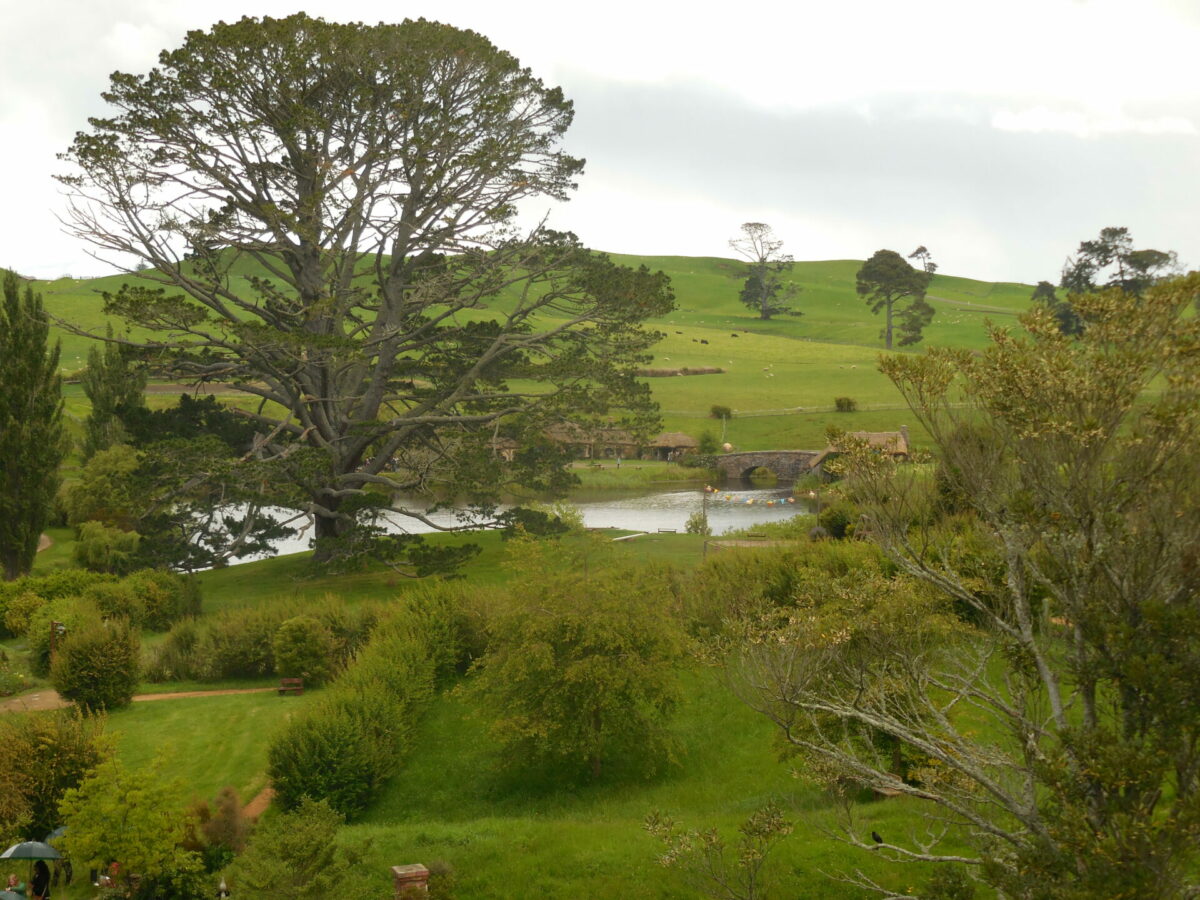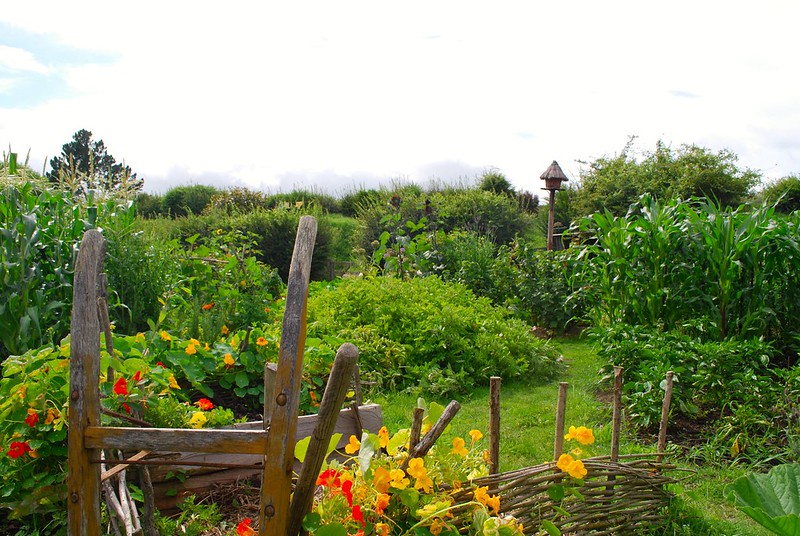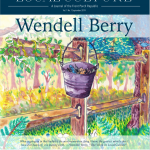Lexington, KY. The significant global trend toward continued urbanization, and its associated effects on air, water, soil, and other kinds of environmental quality, paints a dire picture of the future—a future that has been imagined by many authors as a suite of dystopian urban wastelands. However, other authors, such as J. R. R. Tolkien, have imagined a brighter future—a society characterized by people who care for one another and their natural spaces, cultivating human and ecological flourishing in their communities. This essay analyzes just one character of Tolkien’s imagining, Samwise Gamgee, as a model for human-nature relationships in the primary world. Specifically, I will consider Sam as a gardener, Sam as a curator of local ecological knowledge, and Sam as an urban forester and restorationist.
Firstly, Samwise Gamgee is explicitly a gardener. His introduction in The Lord of the Rings is as the son and occupational heir of Ham Gamgee, who “had tended the garden at Bag End for forty years” (Tolkien, 22). And Bilbo’s garden was well-kept: “The flowers glowed red and golden: snapdragons and sunflowers, and nasturtians trailing all over the turn walls and peeping in at the round windows. ‘How bright your garden looks!’” says Gandalf (Tolkien, 25). Galadriel also describes Sam as a “gardener and lover of trees” when she gives him her gift—a box of soil from her orchard: “Though you should find all barren and laid waste, there will be few gardens in Middle-earth that will bloom like your garden if you sprinkle this earth there” (Tolkien, 375). Later in their journey, passing through “Ithilien, the garden of Gondor now desolate,” Sam is acknowledged by the narrator as a keeper of significant “garden-lore” and knowledge of herbs (Tolkien, 650). Even the Ring recognizes Sam as a gardener, tempting him with the prospect of restoring the vast waste of Mordor—”at his command the vale of Gorgoroth became a garden of flowers and trees and brought forth fruit” (Tolkien, 901). Jeffers argues that “Sam, as a gardener, is able to resist the addictive nature of the Ring because he is able to draw on his experiences of sustaining growth and realizes the folly of the Singular attempting to engulf and enslave the All” (Jeffers, 124). Sam’s work in the garden familiarizes him with the fundamental connections tethering humans and their ecosystems—something Jeffers (124) calls “charitable interconnectedness,” and Dickerson and Evans (75) describe as “complex interdependencies of people, community, and land.” As a gardener, Sam is particularly well-equipped to support both human and ecological flourishing.
In the primary world, urban gardens are increasingly of interest for their ecological and social benefits. Community gardens improve human physical and mental health (Gregis et al. 2021; Lee and Maheswaran, 2011; Wood et al. 2018), as well as community health and cohesion (Egli et al. 2016). Backyard gardens also provide critical pollinator habitat—habitat which can be rare or of poor quality in urban settings (Fukase and Simons, 2016; Leve et al. 2019; Majewska and Altizer 2020; Langellotto et al. 2018). Urban gardens may also help counter the extinction of human-nature experience, providing city-dwellers an opportunity to experience nature in their own backyards and communities (Lin et al. 2018). Gardens thus present a powerful opportunity to reconnect humans with their environment.
However, gardening and agriculture more generally are not without their cultural connotations and implications. The total number of farmers in the US has precipitously declined over the last several decades (USDA ERS), and polls suggest that farming is considered a “less prestigious” occupation (Harris Poll). Furthermore, in an urban context, gardening can be in tension with personal aesthetics and social pressures to conform with preferred landscape management techniques (Larson et al. 2016). In the character of Sam, as well as others such as Farmer Cotton and Farmer Maggot, we see the farmer elevated to the heroic—a rejection of narratives of farming as unprestigious (Dickerson and Evans 84 – 87). Similarly, Jeffers (34) argues that the eventual elevation of Sam and his family to Hobbit nobility is connected, if only indirectly, to his work as a gardener. Sam as a gardener thus encourages us to treat those who cultivate the earth as noble, not to devalue them as unprestigious. He also challenges us each to cultivate our own small gardens in our own spaces with our “own hands,” recognizing our fundamental interconnectedness with one another and with the land (Tolkien, 901).
Connected to his work as a gardener, Sam is a curator of local ecological knowledge and traditions. Sam knows his ecological context. When Ted Sandyman, a Hobbit who ultimately embraces the technological “progress” offered by Sharkey (and may thus represent Sam’s antithesis), suggests that the tree-man Sam’s cousin Hal saw on the North Moors was an actual elm, Sam retorts “there ain’t no elm tree on the North Moors” (Tolkien, 45). Sam knows where one would expect to find particular species of trees across the Shire—and the North Moors is not where one would expect to see an elm. Similarly, when the Hobbits had just begun their journey to Frodo’s new house in Crickhollow, Sam guides them to a good place to camp for the night: “There is a dry fir-wood just ahead, if I remember rightly.” The narrator notes that “Sam knew the land well within twenty miles of Hobbiton, but that was the limit of his geography” (Tolkien, 72). Sam is perhaps most affected by the ravaging of the Shire at the hands of Saruman—he notices that the Party Tree had been cut down, and he is the first to characterize the desolation as Mordor, saying “It comes home to you, they say; because it is home, and you remember it before it was all ruined.” (Tolkien, 1017-1018). Sam’s knowledge of his place exacerbates his grief at its devastation. Ted Sandyman, who likely didn’t know an elm from an oak, couldn’t care less if the environment suffered for the sake of progress—he had his new and improved mill. But Sam—Sam knew every tree and felt its loss: “The trees were the worst loss and damage, for at Sharkey’s bidding they had been cut down recklessly far and wide over the Shire; and Sam grieved over this more than anything else” (Tolkien, 1022). As Brawley (305) notes, “Sam’s main concern, other than Frodo, is with the Shire, and it must be remembered that the last images in The Lord of the Rings are Sam, his wife Rosie, and their daughter Elanor.”
Local and traditional knowledge, while historically marginalized as unscientific and informal, is increasingly seen as critical for socially and ecologically just and sustainable human-nature interactions (Fox and Cundill, 208). Members of local and especially Indigenous communities tend to be more connected to their places than outsiders; they steward knowledge of their places passed down in some cases for thousands of years, knowledge of ecological processes and interactions that informs their interactions with their ecosystems. Because of this, they are well-positioned to address the needs and heal the hurts of their places (Reyes-Garcia et al. 3; Kim et al. 519). As a curator of local ecological knowledge, Sam challenges us to be rooted in our places—to know and care for our places, to know our elms, so to speak, and to know where to find them.
Ultimately, Sam’s knowledge of and affection for his place positions him to restore the Shire after Saruman had devastated it—thus, Sam is also an urban forester and restorer. Counseled by his friends to use Galadriel’s gift to restore the Shire, “Sam planted saplings in all the places where specially beautiful or beloved trees had been destroyed, and he put a grain of the precious dust in the soil at the root of each. He went up and down the Shire in this labour” (Tolkien, 1023). Sam’s efforts to restore the Shire brought about one of the most fruitful years in its history, fruitfulness in both human and ecological terms. Sam’s knowledge of the Shire and his rootedness and groundedness in its soil equip him to heal its hurts. As Dickerson and Evans (156 – 157) note, “Under Sam’s care, we may presume, the quality and extent of these forested areas remain secure, part of the mingled ecology in the complex environment of Middle-earth.”
In the primary world, urban forests are the subject of increasing research and community interest. Urban forests, ranging from street trees to remnant forests and even planted forests (e.g., Smith et al. 2019, Konijnendijk et al. 2006, Oldfield et al. 2013, Sena et al. 2021), provide critical ecological and social benefits (Dwyer et al. 1992). They help to mitigate some of the pollution characteristic of urban areas (Livesley et al. 2016; Kroeger et al. 2014), reduce the impacts of impermeable urban surfaces on stormwater runoff (Oldfield et al, 2013, Brack, 2002; Berlanda et al. 2017), store carbon (Tigges and Lakes, 2017), ameliorate the urban heat island effect (Nowak and Dwyer, 2007), host diverse wildlife populations (Smith and Gehrt, 2010), and provide a suite of socioecological benefits to humans (Poe et al. 2013). Sam as an urban forester and restorer inspires us to similarly give ourselves to the work of restoring our community and urban forests. With time, and a little soil from the Lady’s garden, we can also hope for a fair and fruitful summer.
In the character of Samwise Gamgee, Tolkien thus champions a “love of the land,” which Patrick Curry describes as “a fierce attachment to highly specific and local places and things” (42). Sam is a gardener—an excellent gardener with great knowledge and skill. He is also a curator of local ecological knowledge—he knows the landscape of the Shire, and he knows how the flora and fauna of the Shire are distributed. He also knows and loves its trees—and this love enables him to restore and reforest after Saruman’s devastation. Sam can inspire us to treat our communities, even our cities, as ecosystems—to know their flora and fauna, to cultivate gardens in our own backyards, and to care for and extend our community forests.
An earlier version of this essay was presented at the Texas Literature and Language Symposium, 2021.
—
References:
Berlanda, Adam, Sheri A. Shiflett, William D. Shuster, Ahjond S. Garmestani, Haynes C. Goddard, Dustin L. Herrmannd, Matthew E. Hoptonc. “The role of trees in urban stormwater management,” Landscape and Urban Planning 162, 2017, pp. 167-177.
Brack, C. “Pollution mitigation and carbon sequestration by an urban forest” Environmental Pollution, 116, 2002. doi:10.1016/s0269-7491(01)00251-2
Curry, Patrick. Defending Middle-earth: Tolkien: Myth and Modernity. Houghton, 2004.
Dickerson, Matthew, and Jonathan Evans. Ents, Elves, and Eriador: The Environmental Vision of J. R. R. Tolkien, UP of Kentucky, 2006.
Dwyer, John F., E. Gregory McPherson, Herbert W. Schroeder, and Rowan A. Rowntree, “Assessing the benefits and costs of the urban forest.” Journal of Arboriculture 18(5), 1992, pp. 227-234
Fox, H. and G. Cundill. “Towards increased community-engaged ecological restoration: a review of current practice and future directions.” Ecological Restoration, vol. 36, no. 3, 2018, pp.208-218.
Fukase, J., & Simons, A. M. “Increased pollinator activity in urban gardens with more native flora.” Applied Ecology and Environmental Research, 14(1), 2016, pp. 297-310.
Egli, V., Oliver, M., & Tautolo, E. S. “The development of a model of community garden benefits to wellbeing.” Preventive medicine reports, 3, 2016, pp. 348-352.
Gregis, A., Ghisalberti, C., Sciascia, S., Sottile, F., & Peano, C. “Community garden initiatives addressing health and well-being outcomes: a systematic review of infodemiology aspects, outcomes, and target populations.” International Journal of Environmental Research and Public Health, 18(4), 1943.
Harris Poll. “Doctors, Military Officers, Firefighters, and Scientists Seen as Among America’s Most Prestigious Occupations.” https://theharrispoll.com/when-shown-a-list-of-occupations-and-asked-how-much-prestige-each-job-possesses-doctors-top-the-harris-polls-list-with-88-of-u-s-adults-considering-it-to-have-either-a-great-deal-of-prestige-45-2/. Accessed 18 March 2022.
Jeffers, Susan. Arda Inhabited: Environmental Relationships in The Lord of the Rings. Kent State UP, 2014.
Kim, G., G. Newman, and B. Jiang. “Urban regeneration: Community engagement process for vacant land in declining cities.” Cities, vol. 102, 2020, p.102730.
Konijnendijk, C. C., Richard, R. M., Kenney, A., & Randrup, T. B. “Defining urban forestry – a comparative perspective of North America and Europe.” Urban Forestry & Urban Greening, 4(3-4), 2006, pp. 93-103. https://doi.org/10.1016/j.ufug.2005.11.003
Kroeger, T., Escobedo, F. J., Hernandez, J. L., Varela, S., Delphin, S., Fisher, J. R., & Waldron, J. “Reforestation as a novel abatement and compliance measure for ground-level ozone.” Proceedings of the National Academy of Sciences, 111(40), 2014, E4204-E4213.
Langellotto, G. A., Melathopoulos, A., Messer, I., Anderson, A., McClintock, N., & Costner, L. “Garden pollinators and the potential for ecosystem service flow to urban and peri-urban agriculture.” Sustainability, 10(6), 2018, pp. 2047.
Larson, K. L., Nelson, K. C., Samples, S. R., Hall, S. J., Bettez, N., Cavender-Bares, J., … & Trammell, T. L. E. “Ecosystem services in managing residential landscapes: priorities, value dimensions, and cross-regional patterns.” Urban ecosystems, 19(1), 2016, pp. 95-113.
Lee, A. C., & Maheswaran, R. “The health benefits of urban green spaces: a review of the evidence.” Journal of public health, 33(2), 2011, pp. 212-222.
Levé, M., Baudry, E., & Bessa-Gomes, C. “Domestic gardens as favorable pollinator habitats in impervious landscapes.” Science of the total environment, 647, 2019, pp. 420-430.
Lin, B. B., Egerer, M. H., & Ossola, A. “Urban gardens as a space to engender biophilia: Evidence and ways forward.” Frontiers in Built Environment, 4, 2018, pp. 79.
Livesley, S.J., E. G. McPherson, and C. Calfapietra. “The Urban Forest and Ecosystem Services: Impacts on Urban Water, Heat, and Pollution Cycles at the Tree, Street, and City Scale.” Journal of Environmental Quality Special Section, 2016, pp 119-124.
Majewska, A. A., & Altizer, S. “Planting gardens to support insect pollinators.” Conservation Biology, 34(1), 2020, pp. 15-25.
Nowak, David J., and John F. Dwyer. “Understanding the Benefits and Costs of Urban Forest Ecosystems.” Urban and Community Forestry in the Northeast, 2007, pp. 25–46., doi:10.1007/978-1-4020-4289-8_2.
Oldfield, E. E., Warren, R. J., Felson, A. J., & Bradford, M. A. “Challenges and future directions in urban afforestation.” Journal of Applied Ecology, 50(5), 2013, pp. 1169-1177.
Poe, M.R., R.J. McLain, M. Emery, Patrick T. Hurley. “Urban forest justice and the rights to wild foods, medicines, and materials in the city.” Human Ecology, vol. 41 (3), 2013, pp. 409-422.
Reyes‐García, V., A. Fernández‐Llamazares, P. McElwee, Z. Molnár, K. Öllerer, S. J. Wilson, and E. S. Brondizio. “The contributions of Indigenous Peoples and local communities to ecological restoration.” Restoration Ecology, vol. 27, no. 1, 2019, pp.3-8.
Sena, Kenton L., Zachary J. Hackworth, and John M. Lhotka. 2021. “Forest Development over a Twenty-Year Chronosequence of Reforested Urban Sites.” Forests 12, no. 5: 614. https://doi.org/10.3390/f12050614
Smith, Ian A, Victoria K. Dearborn, and Lucy R. Hutyra. “Live fast, die young: Accelerated growth, mortality, and turnover in street trees.” PLoS ONE 14(5), 2019, e0215846.
Smith, Debra A, and Stanly D. Gehrt. “Bat Response to Woodland Restoration within Urban Forest Fragments.” Restoration Ecology 18(6), 2010, pp. 914–923.
Tigges, Jan and Tobias Lakes. “High resolution remote sensing for reducing uncertainties in urban forest carbon offset life cycle assessments.” Tigges and Lakes Carbon Balance Manage, 12:17, 2017.
Tolkien, J. R. R. The Lord of the Rings, 50th Anniversary Edition, Houghton Mifflin Harcourt, New York, 2004.
United States Department of Agriculture Economic Research Service. Data Products: Ag and Food Statistics: Charting the Essentials. “Farming and Farm Income.” https://www.ers.usda.gov/data-products/ag-and-food-statistics-charting-the-essentials/farming-and-farm-income/. Accessed 18 March 2022.
Wood, E., Harsant, A., Dallimer, M., Cronin de Chavez, A., McEachan, R. R., & Hassall, C. “Not all green space is created equal: biodiversity predicts psychological restorative benefits from urban green space.” Frontiers in psychology, 9, 2018, pp. 2320.






2 comments
Scot Martin
Another thing to consider planting for in our yards and neighborhoods is not simply pollinators. We ought to “consider the birds” as Jesus pointed out by growing native plants in our neighborhoods that attract, feed, and host a myriad of insects. These in turn will bring in birds and other insectivores. Like the elves in Middle Earth, birds and insects are on the decline in ours.
Martin
Yes, Samwise was inspiring, but I don’t consider his gardening ability to be the reason he resisted the Ring. After all, Frodo resisted temptation and he was NOT a gardener. The film strongly suggests that Samwise resisted the lure of the Ring because his focus was on his friend’s well-being: loyalty, not occupational skill. And Sam and Frodo were each tempted at least once.
Generally, a good rambling essay, but I wish it had been formatted for the web, with actual links instead of obscure page numbers to hardcopy sources that FPR readers are unlikely to access. Also, the heavy sprinkling of sources in the text is a serious distraction for a reader, though I realize it is de rigeur for the printed version of an academic speech.
Comments are closed.